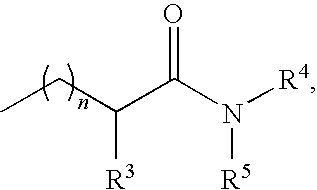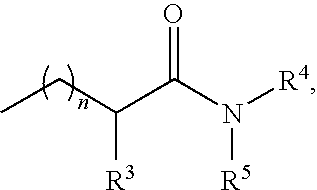Inhibitors of biofilm formation of gram-positive and gram-negative bacteria
a technology of biofilm and bacteria, which is applied in the direction of biocide, disinfectants, antibacterial agents, etc., can solve the problems of inability to identify specific targets for rational drug design, severe damage or diseases of algae in different areas, and inability to prevent or inhibit biofilm growth
- Summary
- Abstract
- Description
- Claims
- Application Information
AI Technical Summary
Benefits of technology
Problems solved by technology
Method used
Image
Examples
examples
Test Method
MBEC™Assay
[0178]The compound to be tested was dissolved in DMSO to obtain a concentration that was 100 times that of the final concentration required (1 mM for the 10 μM assay and 10 mM for the 100 μM assay). 1.5 μL of the above solution was placed into each well of a 96 well plate (final volume in each well=150 μL, final DMSO concentration of 1% (v / v)).
[0179]To grow the organism and form a biofilm, a cryogenic stock of the test organism (at −70° C.) was used. A first sub-culture was streaked out onto TSA (tryptic soy agar), upon which the plate was incubated at 35±2° C. for 24 hours and stored wrapped in parafilm at 4° C. afterwards. From this first sub-culture, a second sub-culture was streaked out onto TSA. The plate was incubated at 35±2° C. for 24 hours. The second sub-culture was used within 24 hours starting from the time it was first removed from incubation. Using the second sub-culture an inoculum in 3 mL sterile water that matches a 0.5 McFarland Standard (1.5×1...
PUM
| Property | Measurement | Unit |
|---|---|---|
| Fouling properties | aaaaa | aaaaa |
Abstract
Description
Claims
Application Information
 Login to View More
Login to View More - R&D
- Intellectual Property
- Life Sciences
- Materials
- Tech Scout
- Unparalleled Data Quality
- Higher Quality Content
- 60% Fewer Hallucinations
Browse by: Latest US Patents, China's latest patents, Technical Efficacy Thesaurus, Application Domain, Technology Topic, Popular Technical Reports.
© 2025 PatSnap. All rights reserved.Legal|Privacy policy|Modern Slavery Act Transparency Statement|Sitemap|About US| Contact US: help@patsnap.com



